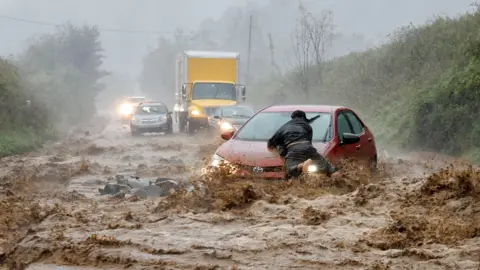
At least 43 people have died and millions left without power on Friday as Hurricane Helene roared through the south-eastern US.
Officials continued daring rescues with boats, helicopters and large vehicles to help those stranded in floodwaters – including about 50 workers and patients who crowded on the roof of a flooded Tennessee hospital.
It was the most powerful storm on record to hit Florida’s Big Bend and moved north into Georgia and the Carolinas after making landfall overnight on Thursday.
Insurers and financial institutions say damage caused by the storm could run into the billions of dollars
Roads and houses were submerged on Friday, with one family describing to BBC News how they had to swim out of their home to safety. Although Helene has weakened significantly, forecasters warn that high winds, flooding and the threat of tornadoes could continue.
Helene, which had been a category four storm, came ashore on Thursday night and remained a hurricane for six hours after it made landfall, according to the Federal Emergency Management Agency (FEMA).
The National Hurricane Center (NHC) said a storm surge – heightened water levels mostly caused by high winds blowing water towards shore – reached more than 15ft (4.5m) above ground level across parts of the Florida coast.
The NHC said the surge should subside before the weekend but the threat from high winds and flooding would persist, including possible landslides.
Up to 20in (50cm) of rain is still possible in places.
The hurricane is the 14th most powerful to hit the US since records began. At approximately 420 miles (675 km) wide, it is behind only two other hurricanes – Ida in 2017 and Opal in 1996, both of which were 460 miles wide.
Because of its sheer size, the impact of strong winds and heavy rain have been widespread across Florida, Georgia, Tennessee and the Carolinas.
At least eight people have died in Florida since Friday, including at least five people in the coastal Pinellas County, the county’s sheriff, Bob Gualtieri said.
The county includes the city of St Petersburg on Florida’s Gulf Coast.
Florida Governor Ron DeSantis said one person died after a road sign fell on their car and another when a tree fell on a hom
After hitting Florida, the storm continued on a deadly path north into Georgia – leaving at least 15 dead – including a first responder, Governor Brian Kemp said.
A suspected tornado that spurred in Wheeler County, in central Georgia, left two people dead when the twister picked up and overturned a mobile home, authorities said.
Kemp ordered 1,000 National Guard troops to help with rescue efforts across the state. The Georgia governor said Friday that more than 150 roads have been closed, 1,300 traffic signals are out across the state and people are still trapped in buildings.
In South Carolina, at least 17 people were killed, according to CBS News, the BBC’s US partner. Neighbouring North Carolina saw at least two fatalities in the storm, one due to a vehicle collision and another when a tree fell on a home in Charlotte, Governor Roy Cooper said.
The state also saw two confirmed tornadoes, which damaged 11 buildings and injured 15 people, the National Service said.
One person was also killed in Virginia, the state’s governor, Glenn Youngkin, said at a news conference on Friday.
Across the southeast, more than three million homes and businesses were without power late Friday, according to tracking site poweroutage.us.
First responders have been tackling rescues, using helicopters, boats and large vehicles to help people stranded in flooded homes. In North Carolina alone, more than 100 rescues have taken place, Cooper said.
In Tennessee, 58 patients and staff were left stranded on the roof of a hospital in the city of Erwin on Friday. Swift-moving water from the Nolichucky River prevented boats from being able to conduct rescue operations, and high winds prevented helicopter rescue.
The group was later taken to safety after helicopters from the Tennessee National Guard and the Virginia State Police intervened.
In Pasco County, north of Tampa on Florida’s Gulf coast, 65 people were rescued. Guests at a Ramada Inn in Manatee County were also rescued as floodwaters rushed into the hotel.
And in Suwannee County to the north, authorities reported “extreme destruction”, with trees falling onto homes.



